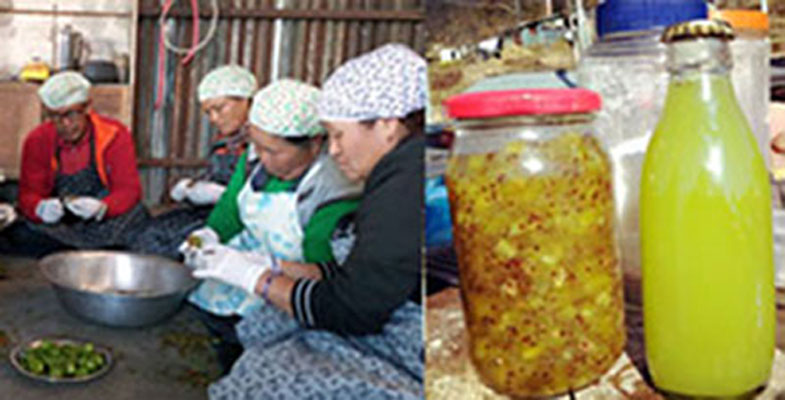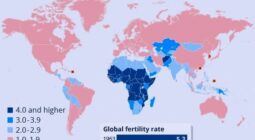Kazi Sarki Lama, 67, recalls spending his entire youth taking care of his orchard in Ghyanghul, a village in Helambu, Nepal. The reputation of his delicious sweet apples had even reached Himachal Pradesh, the scenic mountainous Indian state from where his father had bought his first sapling in 1949.
“Our own juicy apples were also taken back as gifts to Himachal Pradesh because Helambu apples became very famous,” said Kazi, who used to manage an apple orchard with 100 trees.
But in the last 15 years, Kazi says most of the apple trees owned by his family have yielded little or no fruit, forcing them to look for an alternative source for income – kiwis.

Kazi recently planted 100 kiwi trees with the help of Aythos Nepal, a non-profit organization that helps plant and cultivate kiwis in the Himalayas. Aythos has been promoting Kiwi production in the area since 2013.
Helambu is a high-altitude destination in Nepal known for its scenic trekking trails, Buddhist monasteries and sweet apples. A popular tourist destination, the villagers have seen deterioration in its apple quality and quantity due to disease and unpredictable weather patterns.

Nima Lama, another apple farmer, has also switched to kiwi production. Like Kazi’s father, Nima too had brought some apple seeds from Himachal Pradesh in 2006 for his plantation in Helambu.
“But even after so many years, the apple trees have not given good fruit,” Nima said. “After some of my trees started dying, I consulted with many experts, and as per their suggestion, I did more cure with manure and fertilizers, but the seeds in the apples did not stick at all,” said Nima.
Both Nima and Kazi have had to chop trees after the roots died, but lately they are witnessing top soil erosion. “For the last two years, apple trees have been dying from the top,” said Nima.
Dr. Surendra Raj Joshi, a climate and apple expert at the International Centre for Integrated Mountain Development (ICIMOD), and Dr. Ram Prasad Chaudhary, a professor at Tribhuvan University, both claim that climate change is the main reason for the failure of apples to grow in Helambu village.
“Due to climate change, there are not enough bees to pollinate apples, so the apple trees stop bearing fruit,” said Dr. Joshi, underscoring the effects of global warming.
Apple trees need colder temperatures, less than 7 degrees Celsius, to bear fruit, said Dr. Chaudhary. Over the past decade, temperatures have risen by 0.7 degrees Celsius in the Terai lowland regions as well as the hilly areas, and by 1.1 degrees in the Himalayas, he said.
Global Warming – boon for kiwis, bane for apples
Kiwis, also called Chinese gooseberries, grow in temperate regions and hotter climate zones. Initially grown in China, the kiwi fruit is now found all over the world, and are most popular in New Zealand and Italy.
“Our study shows that kiwi cultivation is good in areas like Helambu,” confirmed Shanti Regmi Magar, the Country Director for Aythos Nepal.
Apples usually begin to bloom in February, and need lower temperatures and high volume of water, but kiwis need higher temperatures with less water, said Dr. Joshi, adding that kiwi production has been booming in some areas of Nepal recently.
The locals say it used to snow at least three to five feet in Helambu, but in the last 15 years, there has been no snowfall in the village.
“The village has also not seen temperatures below 7 degrees Celsius for 20 consecutive days in the last decade and a half,” said Dr. Chaudhary. “Some days the temperature is zero degree, some days it is up to 15 degrees.”
According to local elders, there has been no snowfall in the area for about 15 years and mountain ranges are turning to black stones.
“Even if it rains, only one or two inches of snow will fall at most,” said a 60-year-old retired teacher in Helambu who also goes by the popular name of Nima.

Generally, Kiwi cultivation is done at an altitude of 1000 to 2600 meters, according to Aythos’s Magar. Helambu is located at an altitude of 2500 meters above sea level, and recently the temperature in the Himalayas has been rising, leading to melting of glaciers, floods and landslides in Nepal.
Rising temperatures have also resulted in the death of many insects that helped with pollination, said Dr. Joshi.
“Cross-pollination is essential for apples, so kiwi cultivation can be good for apples as well,” Dr. Joshi said, adding that heavy rains and droughts have also resulted in weeds growing on the top soil, hindering proper growth of apple trees.
As kiwi dethrones apple in some parts of Nepal, it is also increasing opportunities and employment for the locals in Helambu. Some are getting trained by Aythos to make jams and wine, even though there is still no easy access to the retail markets because of infrastructural impediments. Some farmers said they have more than 4,000 kgs of kiwi in stock, and the fruits have also attracted tourists.
According to Nima Lama Helmo, a government official, the state government has allocated Rs.60 million for the production of kiwi wine this fiscal year. The government also plans to open a cold storage facility to store kiwis as production increases, he said.
Aythos has also trained members in the Aani Monastery in Ghyanghul to make kiwi jams to sustain their livelihoods. The jams they make are now being sold to other monasteries in Kathmandu, helping them to earn a living.
Will kiwis keep apple away?
To be sure, apple farming has not entirely stopped in Helambu, and the local government is eager to bring back the fame associated with its juicy red fruit.
However, experts say the return of apples to Helambu is possible but to a lesser degree because the tree lines have moved 15 to 20 meters higher and the weather patterns have changed, thereby affecting the life cycle of apples.
Dr. Chaudhary and Dr. Joshi have various theories that could potentially help revive apple production in Helambu. While one said it is necessary to raise bees so that timely pollination can take place, the other suggested snow and water be collected and stored to provide a suitable environment and moisture that will help grow the trees.
According to Dr. Chaudhary, Nepal consumes one lakh metric tons of apples annually. Of that, more than half is imported from China and India, while the rest is produced in Jumla, Mustang, Manang, Mugu, Dolpa, Kalikot and other areas of Nepal.
Meanwhile, farmers like Kazi and Nima are hoping to increase sales of their kiwis with the help of the local government who they trust are banking on advice from agronomists.
However, the biggest hiccups for Helambu farmers remain the lack of a good distribution system and infrastructure roadblocks. Years ago, when Kazi’s father and uncles took their famous Helambu apples to the market, it would take them three days by slow carts across mountainous ranges to reach wet markets in the capital city of Kathmandu, a UNESCO Heritage site, which is about 80 kilometers away. They would often return home with some rotten or crushed apples.
“To avoid the frustration, instead of throwing away (the crushed fruits), some village people tried to make wine from apples,” said Kazi, whose family even started producing apple wine for the village, and sometimes carried them to the city markets too.
This was the time when at least 100 kgs of apples would come from one tree, said Kazi, who hopes that his kiwis will one day become as famous as his apples.
“The pleasure of sleeping under an apple tree and pulling an apple branch and picking the low-hanging apples from the mouth was a different experience,” said Kazi.
(This story was written & produced as part of a media skills development programme delivered by Thomson Reuters Foundation. The content is the sole responsibility of the author)









